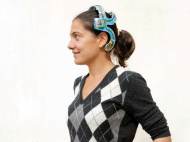Imec’s wireless low-power active electrodes EEG headset
 Imec, Holst Centre and Panasonic have developed a new prototype of a wireless electroencephalogram (EEG) headset which combines ease-of-use with ultra-low power electronics. The system is integrated into imec’s EEG headset with dry electrodes, which enables real time EEG recordings with minimal set-up time and it represents a step towards reliable high-quality wearable EEG monitoring systems.
Imec, Holst Centre and Panasonic have developed a new prototype of a wireless electroencephalogram (EEG) headset which combines ease-of-use with ultra-low power electronics. The system is integrated into imec’s EEG headset with dry electrodes, which enables real time EEG recordings with minimal set-up time and it represents a step towards reliable high-quality wearable EEG monitoring systems.
The small size of the electronics system without the battery measures only 35mm x 30mm x 5mm (excl battery), and it can be easily integrated into other products. Unlike the older version of their system, the new system has continuous impedance monitoring and the use of active electrodes which increase the quality of EEG signal recording. The data is transmitted in real-time to a receiver located up to 10m from the system..
The system integrates circuit level components including imec’s active electrodes and EEG amplifier together with a microcontroller and a low power radio. It is capable to continuously record 8 channel EEG signals while simultaneously recording electrode-tissue contact impedance (ETI). ETI recording enables remote checkup of the electrode contact status during EEG recording.
The heart of the system is the low-power (750µW) 8-channel EEG monitoring chipset. Each EEG channel consists of two active electrodes and a low-power analog signal processor. The EEG channels are designed to extract high-quality EEG signals under a large amount of common-mode interference.
The use of active electrodes lowers the influence from power-line interference and cable motion artifacts – two common causes of lower signal quality. The system can be configured at run-time to change the settings of the recordings such as the number of channels, or enabling/disabling the impedance recording. The autonomy of the system ranges from 22 hours (8 channels of EEG with ETI) to 70 hours (1 channel of EEG only).
The system has a high common-mode rejection ratio (>92 dB), low noise (<6 µVpp, 0.5-100Hz), DC offset tolerance of +/- 900mV and is AC coupled with configurable cut-off frequency. Sensitivity and dynamic range are configurable through a programmable gain stage (default 1.5mVpp and 366nV, respectively).The system (with dry electrodes and no skin preparation) is validated against a commercially available wired reference system (with wet electrodes and skin preparation), comparing the spectra between 1 and 30Hz. The high correlation coefficients (ranging from 0.81to 0.98 in four 1-minute recordings with eyes open) indicate that both systems have similar performance.
The active electrode chips have buffer functionality with high input impedance (1.4GΩ at 10Hz), enabling recordings from dry electrodes, and low output impedance reducing the power-line interference without using shielded wires
Imec and Holst Centre are running Human++ program, where they develop solutions for better healthcare. If you are interested into their technology, you can apply to join imec’s Human++ program as research partner or by licensing agreements for further product development.









Leave your response!